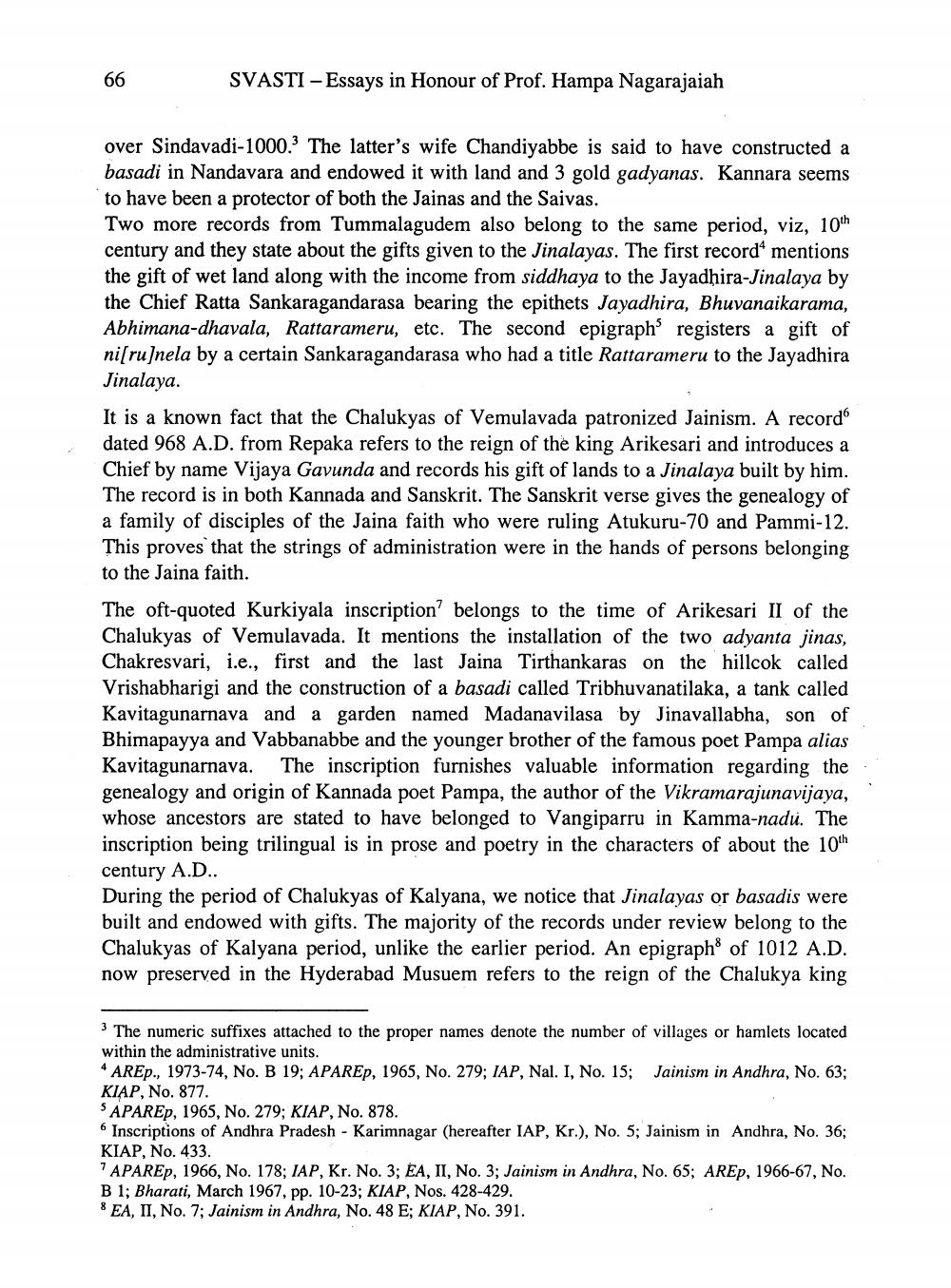________________
SVASTI - Essays in Honour of Prof. Hampa Nagarajaiah
over Sindavadi-1000. The latter's wife Chandiyabbe is said to have constructed a basadi in Nandavara and endowed it with land and 3 gold gadyanas. Kannara seems to have been a protector of both the Jainas and the Saivas. Two more records from Tummalagudem also belong to the same period, viz, 10th century and they state about the gifts given to the Jinalayas. The first record' mentions the gift of wet land along with the income from siddhaya to the Jayadhira-Jinalaya by the Chief Ratta Sankaragandarasa bearing the epithets Jayadhira, Bhuvanaikarama, Abhimana-dhavala, Rattarameru, etc. The second epigraph registers a gift of ni[ru]nela by a certain Sankaragandarasa who had a title Rattarameru to the Jayadhira Jinalaya. It is a known fact that the Chalukyas of Vemulavada patronized Jainism. A recordó dated 968 A.D. from Repaka refers to the reign of the king Arikesari and introduces a Chief by name Vijaya Gavunda and records his gift of lands to a Jinalaya built by him. The record is in both Kannada and Sanskrit. The Sanskrit verse gives the genealogy of a family of disciples of the Jaina faith who were ruling Atukuru-70 and Pammi-12. This proves that the strings of administration were in the hands of persons belonging to the Jaina faith. The oft-quoted Kurkiyala inscription? belongs to the time of Arikesari II of the Chalukyas of Vemulavada. It mentions the installation of the two adyanta jinas, Chakresvari, i.e., first and the last Jaina Tirthankaras on the hillcok called Vrishabharigi and the construction of a basadi called Tribhuvanatilaka, a tank called Kavitagunarnava and a garden named Madanavilasa by Jinavallabha, son of Bhimapayya and Vabbanabbe and the younger brother of the famous poet Pampa alias Kavitagunarnava. The inscription furnishes valuable information regarding the genealogy and origin of Kannada poet Pampa, the author of the Vikramarajunavijaya, whose ancestors are stated to have belonged to Vangiparru in Kamma-nadu. The inscription being trilingual is in prose and poetry in the characters of about the 10th century A.D.. During the period of Chalukyas of Kalyana, we notice that Jinalayas or basadis were built and endowed with gifts. The majority of the records under review belong to the Chalukyas of Kalyana period, unlike the earlier period. An epigraph of 1012 A.D. now preserved in the Hyderabad Musuem refers to the reign of the Chalukya king
The numeric suffixes attached to the proper names denote the number of villages or hamlets located within the administrative units. * AREp., 1973-74, No. B 19; APAREP, 1965, No. 279; IAP, Nal. I, No. 15; Jainism in Andhra, No. 63; KIAP, No. 877. SAPAREp, 1965, No. 279; KIAP, No. 878. 6 Inscriptions of Andhra Pradesh - Karimnagar (hereafter IAP, Kr.), No. 5; Jainism in Andhra, No. 36; KIAP, No. 433. 7 APAREP, 1966, No. 178; IAP, Kr. No. 3; EA, II, No. 3; Jainism in Andhra, No. 65; AREP, 1966-67, No. B 1; Bharati, March 1967, pp. 10-23; KIAP, Nos. 428-429. & EA, II, No. 7; Jainism in Andhra, No. 48 E; KIAP, No. 391.




